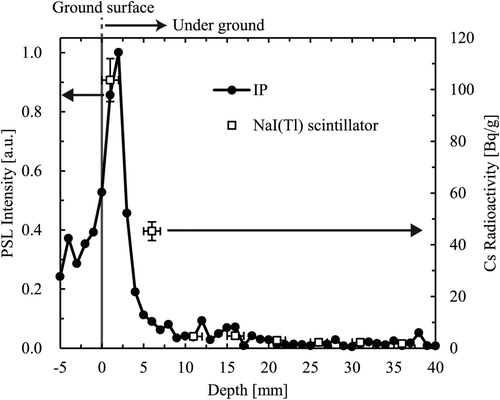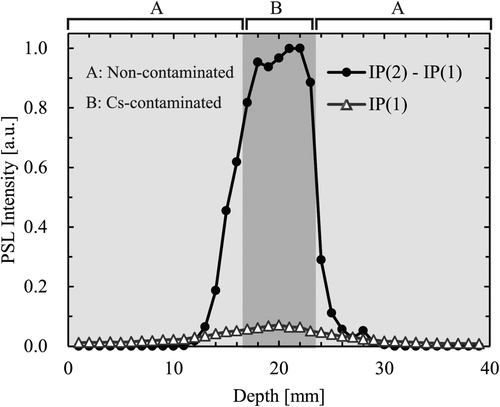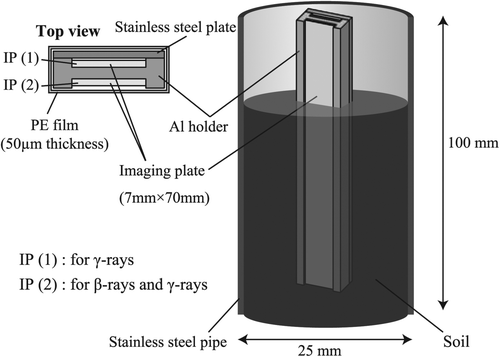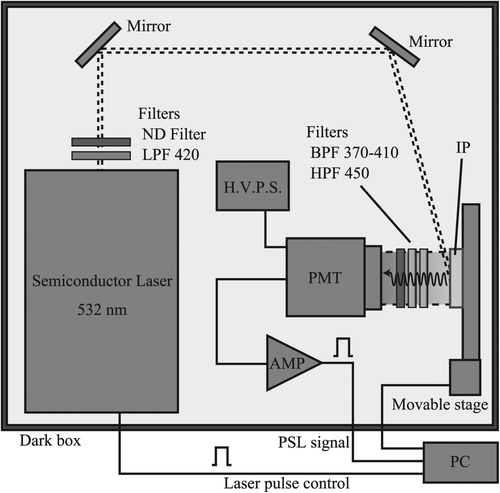Abstract
A simple and convenient system with imaging plates (IPs) was well constructed for the radioactivity examination of soil contaminated with radioactive caesium. A set of two IP strips was vacuum-sealed with thin polyethylene film to prevent the IP strips from direct contacting soil and from being moisturized. In the examination of radioactive soil, a stainless steel pipe including this IP strip monitor was put into the ground and then it was kept in a lead container after being pulled out of the ground for the reduction of the surrounding gamma-ray background. In addition, a sensitive reader was well made for the measurement of the photostimulated luminescence through the scanning of a laser beam on the IP strip. It was confirmed from experiments on actual radioactive-caesium-contaminated soil that the IP strip monitor with the reader effectively detected beta-rays from radioactive caesium and could be satisfactorily used for the examination of radioactive soil.
1. Introduction
Relating to the severe accident of the Fukushima Daiichi nuclear power plant, environmental radioactivity-pollution has been examined in a number of different ways. At present, about 10 months after the 11 March accident in 2011, 134Cs and 137Cs have become major radionuclides that remain in the environment [1]. From a point of radiation protection, it has become important to widely examine the distribution of the ground contaminated with radioactive caesium. A simple and convenient monitor like a litmus paper for radioactivity is expected to be useful for the execution of the radioactivity examination in the wide region as well as a Ge semiconductor or NaI(Tl) scintillation detector is useful for the precise radioactivity measurement of a sample.
In this study, imaging plates (IPs) were used on trial to measure radioactivity in soil. An IP contains photostimulable phosphor of BaFBr:Eu2+ and is well known to be used as a photostimulated luminescence (PSL) image detector, or a dosimeter-type image detector. In soil contaminated with radioactive caesium, an IP responds mainly to beta-rays from the surrounding soil, although an IP is also sensitive to gamma-rays with long mean free path and therefore their contribution to an IP needs to be reduced for precise measurement of radioactive caesium distribution. The aim of this article is to introduce a simple and convenient monitor with IPs for the radioactivity examination of soil contaminated with radioactive caesium. At first this article describes the construction and characteristics of the monitor and then shows examples of examined results on actual radioactive-caesium-contaminated soil.
2. Materials and method
Imaging plates (BAS-TR2025) were prepared for the measurement of radioactive-caesium distribution in soil, and they were clipped into strips which size was 7 mm × 70 mm. shows a schematic drawing of a set of two IP strips, or the IP strip monitor for the examination of radioactive soil. One IP strip (IP (2)) was set in an aluminium holder and its front was covered with thin polyethylene (PE) film to effectively detect beta-rays. A stainless steel plate was set in front of the other IP strip (IP (1)) for measurement of gamma-ray background. The backsides of the IP strips were supported with the aluminium holder. The set of the two IP strips in the holder and the stainless steel plate was vacuum-sealed with thin PE film. This treatment prevents the IP strips from direct contacting soil particles and from being moisturized, which deteriorates characteristics of the IP strips.
In the actual measurement, the set of the IP strips was put into the ground and moreover a 25 mm stainless steel pipe was driven into the ground for the enclosure of the IPs, and finally the pipe including the IPs and surrounding soil was pulled out of the ground. The diameter of the stainless steel pipe was determined in consideration for the range of beta-rays and for the influence of gamma-ray background. The pipe with the IPs and soil was kept in a lead container for the reduction of gamma-ray background. The thickness of the lead shield was 5 cm. The PE film was removed from the set of the IP strips when their PSL was measured.
Although the PSL intensity can be measured with a commercially available IP reader, a compact PSL readout equipment for an IP strip was made in this study. shows a schematic diagram of the home-made reader for an IP strip. The reader is comprised of a semiconductor laser (wavelength; 532 nm, beam spot size; 0.5 mm) for the excitation of an IP strip, a photomultiplier tube (PMT) with optical filters for the detection of PSL photons, a movable stage for the measurement of the PSL distribution on an IP strip, related electronics circuits and a personal computer (PC) for the system control and data acquisition. These components except the PC were set in a dark box of 270 mm × 270 mm × 140 mm.
Depth-directional radioactivity distribution of caesium-contaminated soil in Fukushima prefecture was measured with the present IP strip monitor. In addition, the response characteristics of the monitor were examined by use of artificially-made soil, which was composed of a caesium-contaminated soil layer and a non-contaminated soil layer (soil at Osaka University). This layer type of soil was useful for the evaluation of the spatial (depth-directional) resolution of the IP strip monitor. Moreover, a preliminary caesium-adsorption experiment with the monitor was performed through the addition of a zeolite layer, which is known to be effective for the adsorption of radioactive caesium [2,3]. Alkaline (KOH) solution was poured on the sample soil, and resultant change in depth-directional radioactivity distribution was examined with the present monitor.
3. Results and discussion
In the first experiment, the utility of the IP strip monitor was examined through the radioactivity measurement of caesium-contaminated soil. shows an example of depth-directional radioactive-caesium distribution in a soil core sample in Fukushima, which was measured with the present IP strip monitor and a NaI(Tl) scintillation detector. The pipe including the two IP strips and the soil core sample was kept in the lead container for 24 hours. The depth-directional radioactivity distribution was obtained through the scanning of the laser beam on the IP strips. Moreover, the PSL count of the IP(1) was subtracted from that of the IP(2) for the elimination of gamma-ray background. In addition, the soil core was sliced at a different depth and the caesium-radioactivity of each sample portion was measured with the NaI(Tl) scintillation detector. Results measured with the IP strip monitor approximately agreed with those with the NaI(Tl) scintillation detector, which means that the present IP strip monitor is sufficiently useful for the rough radioactivity examination of soil contaminated with radioactive caesium. The radioactivity distribution was not largely affected by 40K beta-rays in this measurement because potassium was distributed uniformly in soil and they almost equally hit the whole area of the IP. It was found from the distribution of PSL intensity that about 90% of radioactive caesium was in the surface layer of 1 cm in thickness in the soil.
Figure 3. Example of depth-directional radioactive-caesium distribution of soil at Fukushima, which was measured with IP strip monitor and NaI(Tl) scintillation detector.

shows another example of similar radioactive-caesium distribution in sample soil which was prepared for the examination of the spatial (depth-directional) resolution of the IP strip monitor. As shown in , radioactive-caesium-contaminated soil layer of 7 mm in thickness was set at a depth of about 20 mm in non-contaminated soil. The specific activity of radioactive caesium in the contaminated soil was 3.0 × 102 Bq/g. The similar pipe with the IP strips and the sample soil was kept in the lead container for 24 hours. It is clear from the figure that the distribution (IP(2)-IP(1)) nearly represents the profile of the contaminated soil layer and therefore the detection of beta-rays is effective in the examination of soil contaminated with radioactive caesium, or the spatial resolution is on the whole the range of beta rays.
Figure 4. Example of depth-directional radioactive-caesium distribution of sample soil constructed artificially, which was measured with IP strip monitor.

The percolation characteristics of radioactive-caesium were preliminarily examined with the present IP strip monitor. The PSL intensity distributions were measured for the cases with and without the pour of KOH solution into the soil sample, which was composed of Cs-contaminated soil, zeolite and non-contaminated soil layers. shows results of the radioactive-caesium-adsorption experiment with the IP strip monitors, which were performed through the addition of a 3-mm thick zeolite layer to the position between radioactive-caesium-contaminated and non-contaminated soil layers in the pipe. Two sample pipes including the soil with the same composition and the IP strip monitor were prepared, and 0.1N KOH solution of 50 ml was poured on one sample soil. Then the two sample pipes were kept in the lead container for 24 hours. And the depth-directional radioactive-caesium distribution in the soil was examined with the IP strip monitor and was compared between the two samples. As shown in , the shape of the distribution for the sample without KOH solution is similar to that of the distribution (IP(2)-IP(1)) in , while that for the sample with KOH solution clearly indicates the expansion of the radioactive soil layer due to the percolation of radioactive caesium. These results seem to be because radioactive Cs+ ions produced in KOH solution infiltrated into the deeper region and were adsorbed in the zeolite layer.
4. Conclusion
The simple and convenient monitor with the IP strips was successfully made for the radioactivity examination of soil contaminated with radioactive caesium. In addition, the compact and sensitive reader was well constructed for the measurement of the PSL intensity through the scanning of the laser beam on the IP strip. It was confirmed from several experiments on actual radioactive-caesium-contaminated soil that the IP strip monitor together with the reader effectively detected beta-rays from radioactive caesium and could be satisfactorily used for the examination of radioactive soil. This monitor system is also expected to be applicable not only to caesium-radioactivity monitoring for soil but also to various fundamental experiments on caesium-radioactivity transfer, adsorption and others in soil.
References
- MEXT, Monitoring information of environmental radioactivity level.. Available at http://radioactivity.mext.go.jp/en/ (2011).
- Kesraouiouki , S. , Cheeseman , C.R. and Perry , R. 1994 . Natural zeolite utilisation in pollution control: A review of applications to metals' effluents . J. Chem. Tech. Biotechnol , 59 : 121 – 126 .
- Abufasa , A. and Yücel , H. 2002 . Removal of 137Cs from aqueous solutions using different cationic forms of a natural zeolite: Clinoptilolite . Sep. Purif. Technol , 28 : 103 – 116 .


